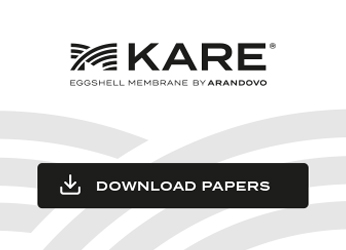High-impact sports are physical activities that involve sudden movements, jumping, twisting and a great deal of force exerted on the body’s joints. These disciplines demand great endurance, strength and agility, but they can also have negative effects on our joints in the long term. In this post by Arandovo, the company that develops MKARE’s functional ingredient, we’ll tell you what impact sports are, which are the most common and how they affect our joints.
What are impact sports?
Impact sports are characterized by the application of force on the joints during said sports practice. These activities often involve jumping, running, rapid changes of direction and sudden movements that place considerable stress on the body’s joints.
Impact occurs when the body makes contact with the ground, other objects or the body itself in an intense manner. This can occur when jumping, landing, performing explosive movements or in situations of physical contact with other players or sports elements.
This force and impact can especially affect the joints of the knees, ankles, hips and elbows, as they are the most exposed to sudden movements and body weight.
It is important to keep in mind that impact is not necessarily negative or harmful to the body. In fact, many sports disciplines require a certain level of impact for optimal performance.
What are the most common high-impact sports?
There are several high-impact sports that are widely practiced around the world. These disciplines involve rapid, repetitive movements that subject the joints to a great deal of force. The most common impact sports are:
Football
Football is one of the most popular sports in the world and is characterized by fast movements, direction changes and physical contact. The constant sprinting, jumping and turning can put great strain on the joints, especially the knees and ankles.
Basketball
This sport involves jumping, running, lateral movements and sudden direction changes. Repetitive landings after jumps and physical contact during play may impact the knees, ankles and hips.
Tennis
Tennis requires explosive movements, rapid changes of direction and strong strokes. The constant impacts when hitting the ball and repetitive shifting motions can affect the elbow, knee and ankle joints.
CrossFit
CrossFit is a high-intensity training discipline that combines different functional exercises, weight lifting and cardiovascular activities. The jumping, lifting and explosive movements involved can place significant stress on joints.
Running
Running or footrace is a high-impact activity that puts constant stress on the joints. The repetitive impacts while running can especially affect the knees, hips and ankles.
Volleyball
Volleyball, both indoor and beach versions, involve jumping, lateral movements and quick hits. Jumping and hard landings, as well as hitting and catching movements, can put stress on the knees, ankles and shoulders.
It is important to mention that this list is not exhaustive and that there are other high-impact sports. In addition, susceptibility to injury and joint wear / tear can vary depending on technique, individual fitness and how each sport is practiced.
It is always advisable to consult with a health professional or a specialized trainer in order to receive personalized guidance and ensure that you practice sports in a safe and healthy manner.
What effects do impact sports have on our joints?
High-impact sports can have significant effects on our joints. The constant repetition of movements and application of force generates a gradual wear and tear on cartilage and joint structures. This can lead to problems such as osteoarthritis, a degenerative disease that affects joint cartilage and causes pain, stiffness and limited movement.
Knees are especially vulnerable in high-impact sports. Jumping, hard landings and lateral movements can cause ligament and meniscus injuries. Similarly, ankles are prone to sprains and strains due to rapid changes of direction and direct impacts.
It is important to mention that the impact on joints can vary depending on the technique and fitness of the individual. Those who engage in high-impact sports improperly or without the proper warm-up and muscle strengthening may be at a higher risk for joint injuries. In addition, factors such as age, body weight and pre-existing conditions like genetic predisposition or previous injuries, may also influence susceptibility to negative effects on the joints.
Despite the potential adverse effects on joints, high-impact sports should not be ruled out. These sports offer numerous health benefits, such as muscle strengthening, motor skill development and improved cardiovascular endurance. However, it is essential to take precautions and adopt measures to minimize the impact on joints and prevent injuries.
Recommendations to take into account when practicing high-impact sports
Important recommendations include proper warm-up before each training session or competition, as well as adequate cool-downs and stretching after physical activity.
In addition, it is essential to use appropriate protective equipment, such as knee, ankle or elbow pads, depending on the sport practiced.
It is also advisable to maintain good technique and posture during sports practice, and to perform muscle strengthening as well as stability exercises to support and protect the joints.
Food supplements for athletes
Food supplements can play an important role in the nutrition and performance of high-impact athletes. These disciplines demand a large amount of energy and nutrients to maintain the level of physical activity and support muscle recovery.
Here are some common supplements that can be beneficial for high-impact athletes:
- Protein powder
Protein is essential for muscle recovery and growth. Protein powder supplements such as whey or vegetable protein help repair and rebuild muscle tissues damaged during high-impact exercise.
- Collagen
Collagen is a structural protein found in the body’s connective tissues, including bones, tendons, ligaments and cartilage. It is essential for maintaining joint structure and strength. Consumption of collagen supplements can provide the amino acids necessary for the synthesis and repair of joint tissues.
- Creatine
Creatine is a compound found in muscle tissue that can improve muscle strength and power. Creatine supplements can be beneficial for high-impact athletes who want to increase their performance in high-intensity, short-duration exercise, such as sprints and weightlifting.
- Omega-3
Omega-3 fatty acids have anti-inflammatory properties and may help reduce inflammation and pain associated with intense exercise. Omega-3 supplements may be beneficial for high-impact athletes who experience stress on joints and connective tissues.
At Arandovo we have developed MKARE, a natural ingredient based on the inner membrane of the egg, which is characterized by its high protein content, bioactive compounds and multiple health benefits such as its regenerating effect and anti-inflammatory power, so it is highly recommended for people who practice high-impact sports.
MKARE is our 100% natural functional ingredient rich in collagen (I, V and X), hyaluronic acid, elastin, chondroitin, sulfate, glucosamine and over 400 proteins that help reduce joint pain induced by exercise and reduce cartilage degradation, as proved by its CTX-II reducing effect.
In addition, MKARE contains 100% native proteins and a membrane purity of 90%. It is a chemical free and clinically tested product to guarantee its maximum quality.
If you want to know everything about the benefits of MKARE or need more information, visit our website or send us a message, we will be happy to help you.




